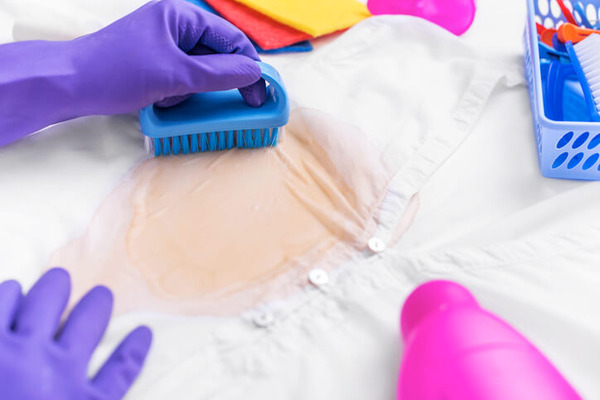Stain Removal Methods for Common Stains
1. Red Wine Stains
There’s nothing worse than accidentally spilling red wine, especially on light-colored clothing or fabrics. Red wine contains tannins, which can easily penetrate fibers and leave a deep, lasting mark if not treated quickly.
Blot immediately: As soon as the wine hits, blot the stain with a clean cloth or paper towel. Avoid rubbing, as this can spread the stain.
Apply salt: Sprinkle salt generously over the stain to absorb the wine. Let it sit for a few minutes before brushing it off.
Use a stain remover or white vinegar: After the initial treatment, apply a commercial stain remover or mix equal parts white vinegar and dish soap. Let it sit for 10-15 minutes, then rinse with cold water. Finally, launder as usual in cold water.
2. Grease and Oil Stains
Whether it’s a drop of salad dressing on your shirt or grease from cooking, oil-based stains can seem daunting because they don’t dissolve in water. The trick is to use substances that absorb or break down the oil.
Blot with a paper towel: Gently blot the excess oil to remove as much as possible before it sets.
Apply baking soda or cornstarch: Cover the stain with baking soda or cornstarch and let it sit for 15-20 minutes. These powders help absorb the oil.
Use dish soap: Since dish soap is designed to cut through grease, it’s perfect for oil stains. Apply a small amount directly to the stain, gently scrub, and let it sit for 10 minutes before washing the fabric in warm water.
3. Blood Stains
Blood stains can be tricky, especially if they’ve dried. Protein-based stains like blood require cold water and gentle handling to avoid setting the stain.
Rinse with cold water: Run cold water over the stain immediately. This helps dissolve the blood and prevents it from seeping deeper into the fabric.
Soak in cold water with detergent: Soak the stained item in a mixture of cold water and laundry detergent for 30 minutes. If the stain remains, apply hydrogen peroxide directly to the area and blot.
Avoid hot water: Heat can cause the proteins in blood to coagulate and bond with the fibers, making the stain harder to remove.
4. Coffee Stains
Coffee spills are a common issue, whether you’re at the office, in your car, or at home. Luckily, coffee stains are water-based and can often be removed with simple household items.
Blot with a clean cloth: Start by blotting the stain to absorb as much coffee as possible.
Rinse with cold water: Run cold water over the stain from the back to help push it out.
Apply liquid detergent: Gently rub a small amount of liquid laundry detergent or dish soap into the stain, then let it sit for 5-10 minutes. Rinse with cold water, and if necessary, repeat before washing the item as usual.
5. Grass Stains
Grass stains are a common problem, especially for active individuals and kids. They can be tough because grass contains pigments that bind to fabric fibers
Pre-treat with detergent: Apply a liquid laundry detergent or stain remover directly to the grass stain. Let it sit for 15 minutes before scrubbing the area with a soft brush or an old toothbrush.
Use white vinegar: For persistent stains, blot with a solution of white vinegar and water.
General Stain Removal Tips and Tricks
Act quickly: The longer a stain sits, the harder it is to remove. Address stains as soon as possible to increase your chances of complete removal.
Blot, don’t rub: Rubbing can push the stain deeper into the fabric, making it more difficult to remove.
Use cold water for protein-based stains: Always use cold water for stains like blood, sweat, or milk to avoid setting the protein in the fabric.
Test stain removers: Before using any cleaning product, especially on delicate fabrics, test it on a small, inconspicuous area to ensure it doesn’t damage or discolor the material.
Avoid heat until the stain is gone: Heat (from a dryer or hot water) can set stains permanently. Make sure the stain is completely gone before drying the fabric.
While stains can be frustrating, they don’t have to spell disaster for your favorite clothes, furniture, or carpets. By understanding the type of stain you’re dealing with and using the appropriate cleaning techniques, you can successfully remove most stains with items you already have at home. Quick action, the right cleaning agents, and patience are key to winning the battle against stains.
